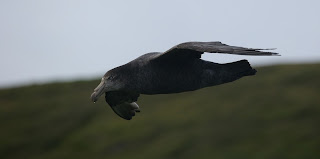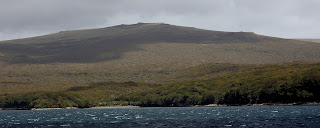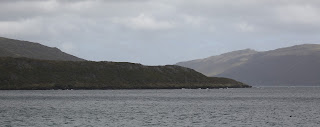It was a bit of a rough
night until we entered more sheltered waters in the ley of Enderby Island. It was 19th
November & I was excited about the days programme: a full day on
Enderby Island! I elected to do the full circumnavigation of the island on foot
& it was a brilliant day!
Our landing & our welcoming committee!
Shirley - now behave!
Male Hooker's Sea Lion protecting his patch.
Two males sparing for beach territory.
The one on the left proved to be the winner.
The pale one is a female who has arrived early
on the beach.
I landed in Sandy Bay with attendant Hooker’s Sea Lions. Most were males,
staking out territory & waiting for the females to arrive, which will
happen over the coming weeks. There were a couple of females on the beach which
had arrived slightly early.
Peter Harrison talking about the day
before we set off.
The Western Cliffs
Me at this brilliant place!
Looks peaceful, but very windy!
Hooker's Sea Lion
They re curious & do come close!
A couple of pairs of
Light- mantled Sooty Albatross
breed on these cliffs.
The nest is on the green bit!
These birds are streamlined, so can nest on cliffs.
Banded Dotterel of the Auckland Island race
.A little paler than the mainland form.
The coast here is quite beautiful.
Part of the group exploring the island.
Eden taking me to the Shag colony.
I am so happy to be here at the bottom of the world!
Auckland Island Shag
This species is not that common,
nesting in small scattered colonies
around the islands.
Incoming!
This colony is probably the only one
at the top of the cliffs!
Part of the blue eyed group.
A young bird.
Lower down on the rocks was this young
Yellow- eyed Penguin
Getting ready for its first venture into the sea.
An adult pair much further up the cliff.
This is the rarest penguin in the world!
Northern Giant Petrels were nesting in low numbers
on the upland areas.
These birds struggle for take off!
Notice the red spot on the tip of the bill.
These birds feed on anything & are totally fearless.
Cute, but not for long!
Totally fearless!
Most of Enderby Island looks like this.
Brown Skuas nest in small numbers in this habitat.
Antarctic Tern
This always seems to be a low density
nesting species, very different from its
northern counterpart.
Rata forest also covers some of this island.
In the more open areas, parakeets occur,
Red Crowned Parakeet
Awesome!
Auckland Island (Sub-antarctic) Snipe
This is a species I have wanted to see for sometime.
Totally awesome!
Auckland Island Pipit
An abundant species on the island.
Like many species here, totally fearless.
Me at this brilliant place!
Looks peaceful, but very windy!
Hooker's Sea Lion
They re curious & do come close!
A couple of pairs of
Light- mantled Sooty Albatross
breed on these cliffs.
The nest is on the green bit!
These birds are streamlined, so can nest on cliffs.
Banded Dotterel of the Auckland Island race
.A little paler than the mainland form.
The coast here is quite beautiful.
Part of the group exploring the island.
Eden taking me to the Shag colony.
I am so happy to be here at the bottom of the world!
Auckland Island Shag
This species is not that common,
nesting in small scattered colonies
around the islands.
Incoming!
This colony is probably the only one
at the top of the cliffs!
Part of the blue eyed group.
A young bird.
Lower down on the rocks was this young
Yellow- eyed Penguin
Getting ready for its first venture into the sea.
An adult pair much further up the cliff.
This is the rarest penguin in the world!
Northern Giant Petrels were nesting in low numbers
on the upland areas.
These birds struggle for take off!
Notice the red spot on the tip of the bill.
These birds feed on anything & are totally fearless.
Cute, but not for long!
Totally fearless!
Most of Enderby Island looks like this.
Brown Skuas nest in small numbers in this habitat.
Antarctic Tern
This always seems to be a low density
nesting species, very different from its
northern counterpart.
Rata forest also covers some of this island.
In the more open areas, parakeets occur,
Red Crowned Parakeet
Awesome!
Auckland Island (Sub-antarctic) Snipe
This is a species I have wanted to see for sometime.
Totally awesome!
Auckland Island Pipit
An abundant species on the island.
Like many species here, totally fearless.
I walked the boardwalk to the Western Cliffs & then walked clockwise around the island. It
was very open & windswept with all four seasons sometimes in one hour!
Everything from sunshine to rain & even hail. Exhilarating stuff!
Best birds included:
2 Auckland Island Flightless Teal;
15+ Yellow eyed Penguin; 12 Southern Royal Albatross; 5 Light mantled Sooty
Albatross; 40+ Northern Giant Petrel; 50+
Auckland Island Shag; 7 Auckland
Island Banded Dotterel; Auckland Island
Snipe; 8 Ruddy Turnstone; 5 Antarctic Tern; 60 Brown Skua; 30+ Red crowned
Parakeet; 7 Auckland Island Tomtit; Auckland Island Pipit were very common
& 80+ Common Redpoll.
We had a re-arrangement of
the schedule as a lady had fallen on the ship during the previous nights rough
seas & it appears she had broken her hip. So we stayed in sheltered waters.
Expedition staff coming back from the evacuation.
Please note, I decided not to take any photos
of this event.
I stayed in bed on the
morning of 20th November.
We stayed in place waiting for the helicopter to arrive & it duly did
although a little later than anticipated, around 1pm.
Selina walking through the Rata Forest
on the way to the hut.
it is sheltered & wet in the forest.
This young Bellbird came to investigate me!
The coast watchers hut
Pretty spartan!
It must have been a tough life here.
Due to oncoming severe
weather we stayed in the shelter of the island & made another landing to
where coast watchers lived during World War Two. Several of these men became
prominent New Zealand naturalists in later years. It must have been quite a
tough life though.
As one climbs higher, the forest dwindles away
into established heath type vegetation.
The scenery was amazing!
My temporary home in the distance!
Just to prove I was in this amazing landscape!
We climbed to the top of the
hill & enjoyed fantastic views over this amazing sub antarctic landscape.
Due to the bad weather, we
stayed at anchor in a sheltered bay & only set sail heading south down the
main island during the night.
White capped Albatross
Sub-antarctic Shearwater
The best I could do in the circumstances!
I was on deck early on the 21st November. It was quite
rough, with lots of spray but not too bad. There were a lot of White capped
Albatrosses about & I managed to find a Sub Antarctic Shearwater. Had fairly good views through the
binoculars & managed a couple of record shots.
Carnley Harbour
Notice the silvery under wing.
Notice the white scapular markings
Perhaps a new species for science!
Light-mantled Sooty Albatross breed on the cliffs.
Sooty Shearwater also breed here
in there tens of thousands.
The light was terrible!
Showing the silvery under wing.
Plenty of Sooty Shearwaters loafing on the sea,
waiting to go to their breeding grounds at night.
They were all in front of the ship, only getting
out of the way at the last minute.
As we entered Carnley Harbour (which is a huge
entrance to a sunken caldera) I spotted a diving petrel. The very striking
white under wing & white scapular markings confirmed it as the so called
South Georgia Diving Petrel. I say this because current research will almost
certainly prove this to be a new species for science & called Sub Antarctic Diving Petrel!
We then made a landing in Tagua Bay & walked through the rata
forest to another lookout with a grand vista.
Early afternoon we headed
south into the ocean. The weather was bad, but according to the forecast should
improve! It is a long sea haul of 360 nautical miles to Macquerie Island our next amazing destination.
I tried to get photos, but it
was impossible to be outside for safety reasons! I joined the other birders on
the bridge but very quickly that number became reduced! It was a time for
battening downs the hatches & for many, taking to ones bed. I remained on
the bridge for the next six hours. It was exhausting, twisting & turning
with the huge waves & sideways swells. But I stuck it out & was
rewarded with a truly fantastic days birding.
Best birds included:
5 Gibson’s Wandering
Albatross; Antipedian Wandering Albatross; 18 Wandering Albatross; 13 Southern
Royal Albatross; Campbell Albatross; Grey Headed Albatross; 250 White Capped
Albatross; 10 Light Mantled Sooty Albatross; 15+ Northern Giant Petrel; 15 Cape
Petrel; 200+ Antarctic Prion; 10 Fairy Prion; 14 Mottled Petrel; 450+ White
Headed Petrel; 10 White Chinned Petrel; 3,000++ Sooty Shearwater; 28
Subantarctic Little Shearwater; Grey backed Storm Petrel; 45+ Black bellied
Storm Petrel; 23 South Georgian Diving ( Sub-antarctic) Petrel; 25 Diving petrel sp; 10 Auckland
Island Shag & 2 Antarctic Tern.
It was a terrific days sea birding, but I had to leave the bridge in fading light & even worse sea conditions.
It was bed time for me at 9 pm!






















































































































No comments:
Post a Comment